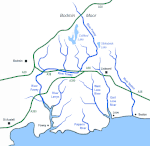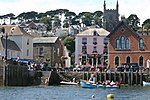Sawmills Studios
Music venues in CornwallRecording studio stubsRecording studios in EnglandUse British English from January 2013

Sawmills Studios is a recording studio founded in 1974 by record producer, Tony Cox. It is located in Golant, on the banks of the River Fowey in Cornwall.
Excerpt from the Wikipedia article Sawmills Studios (License: CC BY-SA 3.0, Authors, Images).Sawmills Studios
School Hill,
Geographical coordinates (GPS) Address Nearby Places Show on map
Geographical coordinates (GPS)
| Latitude | Longitude |
|---|---|
| N 50.354197 ° | E -4.641 ° |
Address
School Hill
PL23 1LR , St. Sampson
England, United Kingdom
Open on Google Maps










